Light Savers: The making of the UV wand
A baby backpack + bulbs + batteries + brainpower = a germ’s worst nightmare
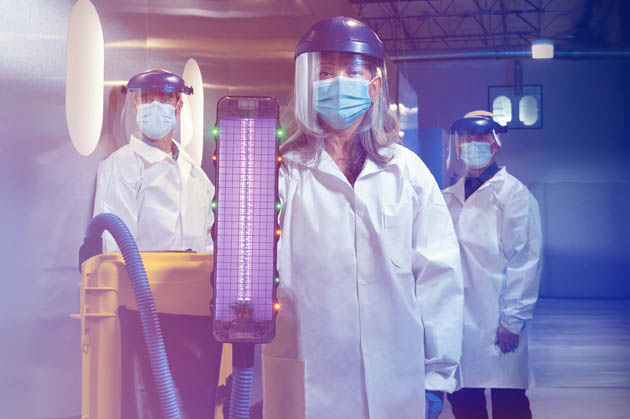 UV THREE: (From left) Boeing engineers Kevin Callahan, Teresa King and Jamie Childress with the UV wand at Boeing’s Concept Center in Everett, Washington. They led a team that turned a concept into a device that could change the way airplanes are sanitized. PHOTO: MARIAN LOCKHART
UV THREE: (From left) Boeing engineers Kevin Callahan, Teresa King and Jamie Childress with the UV wand at Boeing’s Concept Center in Everett, Washington. They led a team that turned a concept into a device that could change the way airplanes are sanitized. PHOTO: MARIAN LOCKHART
If they could, pathogens would run and hide at the sight of the purple glow emanating from the Boeing-developed ultraviolet wand. Rapidly yet carefully created by a dedicated team to destroy germs on the inside of airplanes, the UV wand could become standard operating equipment. Teresa King, Jamie Childress and Kevin Callahan were on the front lines of this innovation. They take us inside Boeing’s Concept Center to reveal what they did and how they did it.
IQ: Begin at the beginning. Trace the genesis of the UV wand.
Childress: The story is a bit like a rock band that seems to arrive on the scene from nowhere, only for new fans to discover the band has been touring small venues for years. The UV wand was first hatched in my brain way back in 2014 when I first found out 222 nm (nanometer) UV light killed pathogens and is safe for human exposure. Back then the data for both those claims was slim but seemed compelling all the same.
At the time, I was primarily working military projects, so my natural inclination was to apply this technology in that space. I envisioned a “disinfection Swiss Army knife” that could safely sanitize anything from pots and pans to combat wounds.
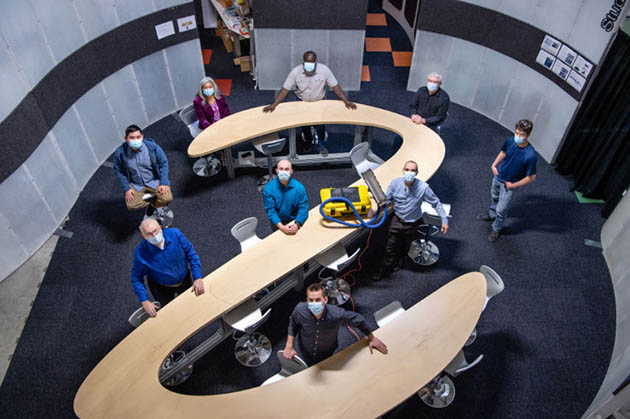 TEAM EFFORT: The core UV wand development team gathers at Boeing’s Concept Center in Everett, Washington. From top left: Ang “Sam” Sherpa, Teresa King, Yakentim Ibrahim, Doug Brown, Chris Plass, Kevin Callahan, Jamie Childress, Art Brockschmidt and Michael Klein. PHOTO: MARIAN LOCKHART
TEAM EFFORT: The core UV wand development team gathers at Boeing’s Concept Center in Everett, Washington. From top left: Ang “Sam” Sherpa, Teresa King, Yakentim Ibrahim, Doug Brown, Chris Plass, Kevin Callahan, Jamie Childress, Art Brockschmidt and Michael Klein. PHOTO: MARIAN LOCKHART
IQ: How did the idea move to the next level?
Childress: An idea is just an idea until it has a customer. My first customer was not the military. It was Teresa King. As leader of Boeing’s Clean Cabin Program, she immediately grasped the value of 222 nm UV for commercial aircraft.
Under Teresa’s leadership, we had developed the UV lavatory, which features several clean technologies, including 222 nm UV disinfection. When COVID-19 hit, Teresa informed her management about the wand I was developing.
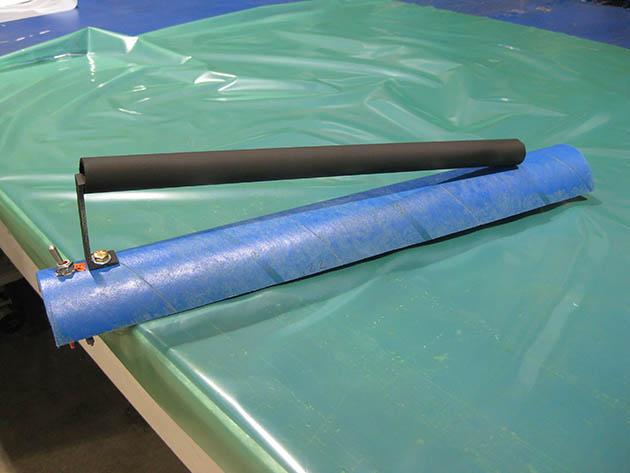 FIRST OF ITS KIND: Boeing engineer Jamie Childress spray-painted a shipping tube for this first UV wand concept. PHOTO: JAMIE CHILDRESS
FIRST OF ITS KIND: Boeing engineer Jamie Childress spray-painted a shipping tube for this first UV wand concept. PHOTO: JAMIE CHILDRESS
King: Capitalizing on our UV lav work, we knew a lot about the technology after years of research into 222 nm wavelength. We’d done our homework on the power required to disinfect using this wavelength in the least amount of time possible. And we’d spent hours (internally and externally) testing efficacy, material compatibility and safety of use. The urgency of the pandemic propelled us to a minimum viable product in record time. This is where we turned to the Concept Center, led by Kevin Callahan, to bring it home. And boy, did they deliver.
IQ: How did the UV lavatory play a role?
King: When our Boeing Research & Technology Tech Fellow Jamie came to us in Product Development with this UV technology back in 2015, it sparked the clean cabin revolution. It was the first time we looked at a solution from a holistic perspective. We later launched the clean cabin self-disinfecting lavatory as a featured suite of products. It was our first Product Development study centered on a UV disinfection system.
Childress: The UV lav was installed on the 2019 ecoDemonstrator 777-200. A critical part of that was a flight-worthy 222 nm power supply designed and built by Art Brockschmidt, a retired Boeing Technical Fellow and current contractor. Art modified that same power supply in his home workshop for the UV wand. His contribution cannot be overstated. That power supply is practically everything.
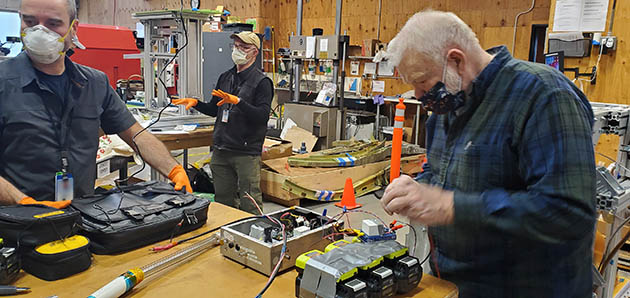 WORKSHOP IT: (Left to right) UV team members Kevin Callahan, Jamie Childress and Art Brockschmidt work during the duct tape stage of the UV wand development at Boeing's Concept Center in Everett, Washington. PHOTO: TERESA KING
WORKSHOP IT: (Left to right) UV team members Kevin Callahan, Jamie Childress and Art Brockschmidt work during the duct tape stage of the UV wand development at Boeing's Concept Center in Everett, Washington. PHOTO: TERESA KING
It was assumed at the time that the system could be plugged in but would also need batteries for mobility. So Art worked on battery power for the power supply, and I worked on a backpack that could carry it all.
By the end of April 2020, we had preliminary prototype versions with all the key elements of the system: power supply, lamp, cooling system, lamp housing geometry, backpack, extendable handle, ranging LEDs, batteries and charger.
IQ: Sounds like you were inventing in parallel to the emergence of the pandemic?
Childress: At about the same time, I was told there was a critical need for rapid UV disinfection of flight decks.
Callahan: Flight decks are conventionally cleaned using liquid disinfectants. But given the many switches, buttons and dials, it can be a long, intricate process. The urgency of the pandemic required a more efficient approach. Knowing about Jamie’s UV wand, I subsequently proposed its use for commercial flight decks.
IQ: What transformed idea into product?
Callahan: The real transformation into a product occurred when the team observed the challenges of existing disinfection methods in sensitive areas such as flight decks. It was the new awareness of this need, paired with Boeing-developed UV technology from Teresa and early concepts like Jamie’s, that created the product — one that helps airline customers restore crew confidence in the face of the pandemic.
IQ: When did it feel real?
Callahan: I assembled a team to form what became the mobile UV Product Development team. Our charter was to understand what product our airline customers actually wanted. We already had the technology, thanks to Teresa, Jamie, Art and others; the task was to develop the product.
Childress: On Saturday, May 2, 2020, we all met at Boeing’s Concept Center in Everett, Washington. It was the first time I had actually seen everyone in person this whole time. Art brought his power supply and battery setup. I brought a wand housing, wand handle, LED light ranging system and a preliminary cooling hose/fan. Kevin and Teresa’s team did a brilliant job of taking that tinkertoy pile of preliminary hardware and turning it into something airlines could use.
IQ: Word is, a baby backpack was part of the original design?
King: We had everything from hiking packs to vacuum packs to baby backpacks. Everyone was asked to bring what they had from home and share what they thought might work. I was actually partial to the vacuum backpack at the time. Everyone, of course, couldn’t stop making correlations to the Ghostbusters’ proton packs.
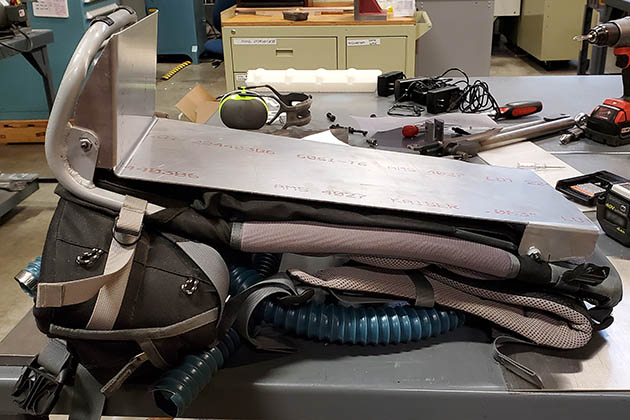 PACK LEADER: UV development team member Mike Klein repurposed his family’s baby backpack (with his wife’s permission) to hold batteries and the power supply. PHOTO: TERESA KING
PACK LEADER: UV development team member Mike Klein repurposed his family’s baby backpack (with his wife’s permission) to hold batteries and the power supply. PHOTO: TERESA KING
Callahan: Yes, after Jamie’s early backpack prototypes, the development team switched to an infant-carrying backpack, since one of our team members had an old one in his garage. His wife said OK, and the backpack took on a whole new life. There was an incredible number of trips to local hardware and industrial stores. We purchased shop blowers, insecticide applicators, backpacks, vacuum cleaners, power tool batteries, nuts, bolts, sheet metal, rubber hose, activated charcoal (for aquariums), window screen, PVC pipe and plywood.
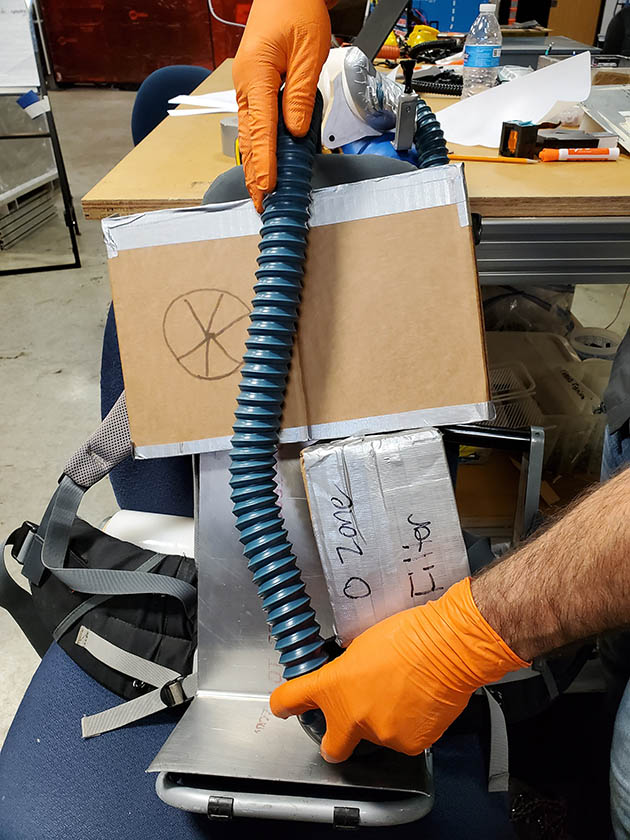 THE DRAWING BOARD: A primitive model of the UV wand was crafted out of cardboard, a vacuum hose and duct tape. PHOTO: TERESA KING
THE DRAWING BOARD: A primitive model of the UV wand was crafted out of cardboard, a vacuum hose and duct tape. PHOTO: TERESA KING
We first laid out all of the critical components, “Apollo 13” style, that Jamie and Art had already developed and set about integrating those into a product demonstrator. In just six days, we made a fully operational UV wand backpack.
IQ: How did you determine what airlines required?
Callahan: We coordinated with a number of major airlines, both international and domestic, and worked with even more to understand what the product needed to be. We produced and executed a customer engagement process that included research protocol, structured feedback, demonstrations and interviews with objective users (cleaning vendors and airline staff).
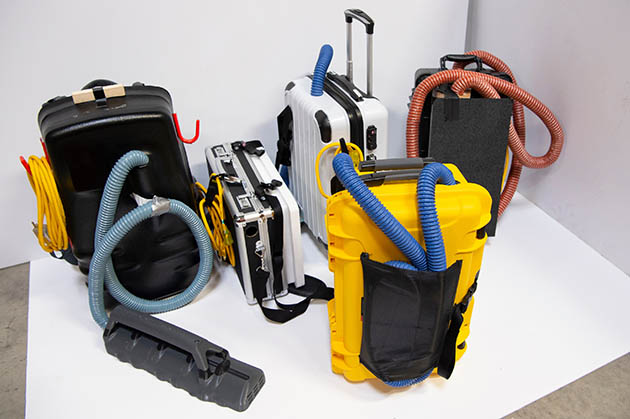 GENERATING SUCCESS: Five generations of the UV wand were shaped by airline evaluation. PHOTO: MARIAN LOCKHART
GENERATING SUCCESS: Five generations of the UV wand were shaped by airline evaluation. PHOTO: MARIAN LOCKHART
IQ: The original UV wand unit included a backpack. Why did you add wheels to make it look more like carry-on luggage?
Callahan: We had to overcome the confirmation bias we all had toward the backpack design. Though we thought it was the right product, airlines told us otherwise. It took careful, objective questioning and engagement with airlines to identify their needs and operational constraints. This is what user research is all about. The usability study conducted with our customers revealed that a new form factor was required; and so was born the Gen 2.0 wheeled bag design.
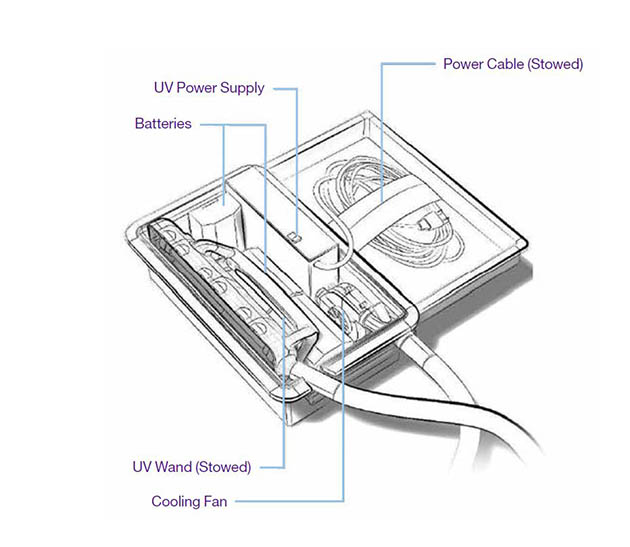 UNDER THE HOOD: Boeing’s latest version of the UV wand system tucks into a case the size of carry-on luggage. Manufacturers may modify components in the future. PHOTO: BOEING
UNDER THE HOOD: Boeing’s latest version of the UV wand system tucks into a case the size of carry-on luggage. Manufacturers may modify components in the future. PHOTO: BOEING
IQ: How many all-nighters did you pull?
Childress: Since mid-March I’ve pretty much been in my lab seven days a week, with the occasional exception. However, I have not pulled any all-nighters. Kevin or Teresa would take the trophy on that one.
Callahan: Yak Ibrahim, Ang (Sam) Sherpa and I stayed up 36 hours to build and power up what became the final prototype to get it ready for testing.
King: I had it easy. I only remember one night where I actually worked straight through. (A silver lining to working virtual: I didn’t have to drive anywhere, so I barely had to comb my hair.) But there were many long days and nights (I’m a night owl) spent getting organized and sifting through piles of historical data to pull together presentation materials for our new mission. The Concept Center team resolutely worked right through the summer with few breaks. They were unstoppable. I couldn’t even force them to take time off. They were determined to get the prototype working. One evening while struggling with a power supply issue, one joked, what are the chances Art, our retired Tech Fellow, would be up at 2 in the morning? Sure enough, he was indeed up and online. Together, they worked through the night, troubleshooting the issue.
IQ: Did you ever think it was impossible?
Callahan: Yes, the night of the all-nighter was one of those times. Everything seemed to be just one step away from working. When we fixed one issue, another would then be identified. It seemed endless. It was the sheer determination of the team to push forward after every setback, understanding how important this was to passengers, airlines and Boeing.
King: If Kevin or the team had doubts, they never shared them with me. I trusted them fully to make this work. We also had great support from key people along the way that made this possible. Everything had to align just perfectly. Thanks to herculean efforts by all team members involved, we did it. We were truly empowered to work across the entire enterprise.
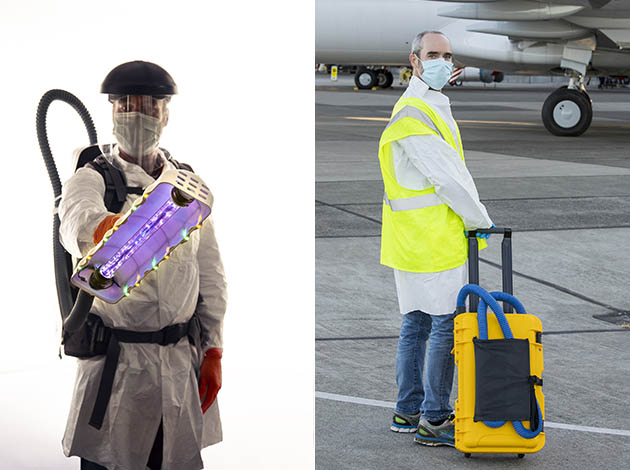 ROLL CALL: Incorporating feedback from airlines, the original backpack design evolved into a rollercase for ease of transport and use. PHOTO: TOMMY PRYOR / LIZ WOLTER
ROLL CALL: Incorporating feedback from airlines, the original backpack design evolved into a rollercase for ease of transport and use. PHOTO: TOMMY PRYOR / LIZ WOLTER
IQ: Have you ever invented anything so rapidly?
Childress: Not in my 33 years at Boeing. Not even close.
Callahan: Invented, yes, developed into a real product, absolutely not! This is far and away the fastest development I’ve ever seen at Boeing. A process that normally takes two or three years, we accomplished in six months.
King: Our success with the mobile UV wand does play into the myth of the overnight sensation. But like most overnight sensations, it took years of hard work and continued diligence to allow us to more quickly arrive at what most see and recognize, the last step.
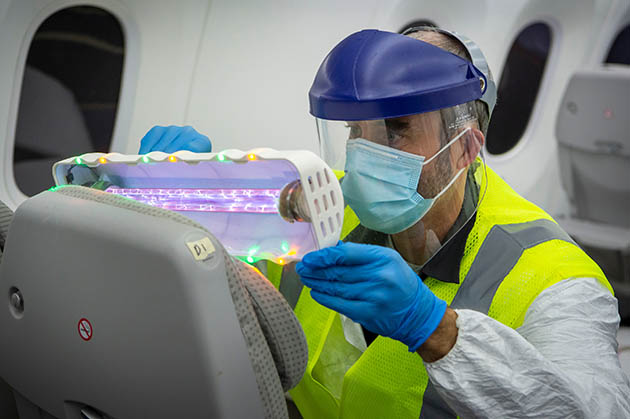 REST EASY: Green and orange lights guide operators, like Boeing engineer Kevin Callahan, to the ideal distance for maximum effectiveness against germs. PHOTO: MARIAN LOCKHART
REST EASY: Green and orange lights guide operators, like Boeing engineer Kevin Callahan, to the ideal distance for maximum effectiveness against germs. PHOTO: MARIAN LOCKHART
IQ: Now that airlines can order the Boeing-developed UV wand (Healthe Inc. and Far UV Technologies will produce and distribute the commercial device), how gratifying is it to see concept become reality?
Childress: Not all research and development efforts actually make it to the real world. This one got there much faster than any other I’ve ever been involved with.
Callahan: It renews my belief that Boeing has the most amazing talent, excellent leadership and capacity to do great things under the most challenging of circumstances.
King: I think the most satisfying aspect is finding partners who share our passion about what this technology enables and our drive to help get our passengers, crew and airlines safely back into the air. I can’t wait to get back up in the skies again.
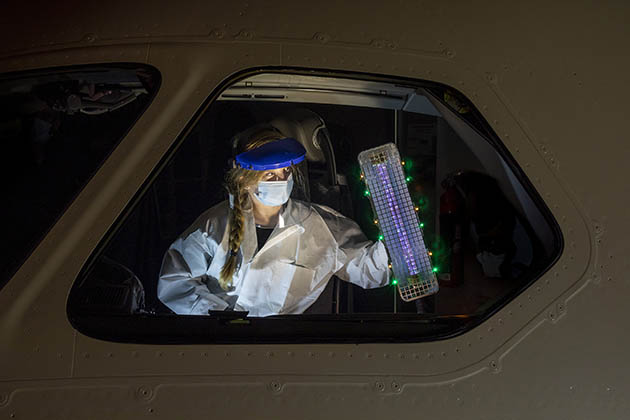 DECK DISINFECT: The UV wand was rigorously evaluated in compact spaces such as a flight deck. PHOTO: LIZ WOLTER
DECK DISINFECT: The UV wand was rigorously evaluated in compact spaces such as a flight deck. PHOTO: LIZ WOLTER
IQ: How does this innovation serve the greater good?
Callahan: The Concept Center team took the UV technology and early concepts and created a minimum viable product definition. We validated that definition with airline customers; performed user research; conducted usability testing at Boeing facilities; and, through a rapid development processes, designed and built a near-production prototype used to demonstrate viability to licensees. The real product, however, is restored crew and passenger confidence. The UV wand is simply one of the means to achieve that. Understanding this enabled our success.
PLUGGING IN TO THE BIG PICTURE
The UV wand is a part of Boeing’s Confident Travel Initiative to lead in the global effort to provide passengers and crew a safe, healthy and efficient travel experience. This includes working to minimize air travel health risks amid the COVID-19 pandemic; driving awareness of existing health safeguards, the cabin environment, and cleaning and disinfection processes; and developing and testing new solutions.
We are treating COVID-19 like any threat to the safety of an airplane: assessing the hazard, understanding the environment and applying proven aerospace engineering practices and data to find solutions.
The risk of contracting COVID-19 during air travel is extremely low compared to typical daily activities. Effective cleaning solutions, passenger responsibility, cabin geometry and the HEPA filter-backed cabin air environment are part of the multilayered approach to protect against COVID-19, helping to ensure the health and safety of every person who steps on board. Going forward, we will continue to evaluate new technologies and techniques that may improve safety in the airplane cabin environment.






